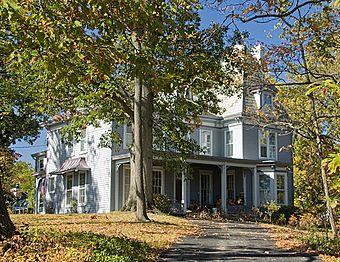Luethstrom–Hurin House facts for kids
Quick facts for kids |
|
|
Luethstrom–Hurin House
|
|

Front, seen from Reily Road
|
|
| Location | 30 Reily Rd., Wyoming, Ohio |
|---|---|
| Area | 1.2 acres (0.49 ha) |
| Built | 1865 |
| Architectural style | Second Empire, Italianate |
| MPS | Wyoming MRA |
| NRHP reference No. | 86001635 |
| Added to NRHP | August 25, 1986 |
The Luethstrom–Hurin House is an old and important home in Wyoming, Ohio, United States. It was built in the 1860s and changed a lot by 1875. This house was once home to two important businessmen. They worked in the local grain and flour business. The house is now a historic site because of its special design.
What the House Looks Like
The Luethstrom–Hurin House is made of wooden boards. It has a strong stone base and a slate roof. When it was first built in 1865, it looked like a simple Italianate style house. It had five sections on its front.
This look did not last long. By 1875, more parts were added to the back of the house. In 1885, new changes made it look like a Second Empire style home. This included a tall tower and a roof with special windows called dormers.
The tower sticks out from the right side of the house when you look at it. A bay window also sticks out from the tower. A small porch covers the front door and other parts of the house. Fancy brackets hold up the roof's edge above the second-story windows.
Why Wyoming Grew
Wyoming became a successful city because of good ways to travel. The city is near an old road that connected Cincinnati to places like Fort Hamilton. This road was made straighter in 1806. Today, it is part of Springfield Pike.
In the 1830s, travel became even better. The Miami and Erie Canal was built nearby in 1828. A village called Lockland grew up next to the canal. In 1851, trains also came to the city. The Cincinnati, Hamilton, and Dayton Railroad was built between Lockland and Wyoming.
Because of these easy ways to travel, many rich business people moved to Wyoming. They bought farms and built large country homes. Most of these homes were in the Wyoming Hills area. This area grew until the Great Depression.
The first owner of the Luethstrom–Hurin House was Mr. Luethstrom. He was a partner in a company that sold grain and flour. The next owner was James Hurin. He moved in with his family in 1874. Mr. Hurin was the president of a flour mill in Cincinnati. He worked in the same business as Mr. Luethstrom.
A Special Historic Place
In 1979, a local group started looking for historic buildings in Wyoming. This led to many homes being added to the National Register of Historic Places in 1985. This list includes important places in the United States.
The Luethstrom–Hurin House was added to the Register in 1986. It was chosen because of its important and special design. It is one of five homes on Reily Road that are on this list. The others are the Charles Fay House, the John C. Pollock House, the Louis Sawyer House, and the William Stearns House.



